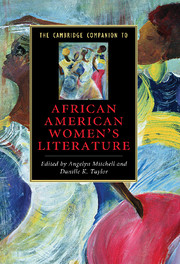Book contents
- Frontmatter
- Introduction
- Part 1 History, contexts, and criticism
- Part II Genre, gender, and race
- 6 African American women and the United States slave narrative
- 7 Autobiography and African American women’s literature
- 8 “Even some fiction might be useful”: African American women novelists
- 9 African American women poets and the power of the word
- 10 African American women in the performing arts
- 11 African American women writers of children’s and young adult literature
- 12 African American women essayists
- 13 African American women writers and the short story
- 14 African American women writers and popular fiction: theorizing black womanhood
- Bibliography
- Index
8 - “Even some fiction might be useful”: African American women novelists
from Part II - Genre, gender, and race
Published online by Cambridge University Press: 28 July 2009
- Frontmatter
- Introduction
- Part 1 History, contexts, and criticism
- Part II Genre, gender, and race
- 6 African American women and the United States slave narrative
- 7 Autobiography and African American women’s literature
- 8 “Even some fiction might be useful”: African American women novelists
- 9 African American women poets and the power of the word
- 10 African American women in the performing arts
- 11 African American women writers of children’s and young adult literature
- 12 African American women essayists
- 13 African American women writers and the short story
- 14 African American women writers and popular fiction: theorizing black womanhood
- Bibliography
- Index
Summary
Octavia Butler's science-fiction novel Parable of the Sower (1993) depicts a dystopian future society riven by racial and class war. Anticipating the impending collapse of her social world, the novel's protagonist Lauren Olamina assembles a survival kit that contains (among other items) various kinds of reading material, including novels. “Even some fiction might be useful,” says Lauren, and she turns out to be right, as the books she has salvaged supply valuable information that helps her survive hunger and thirst as well as social chaos. The life-saving power of fiction emerges as a recurrent motif in African American women's novels published from the mid nineteenth to the early twenty-first century. Harriet Wilson, the first black woman to publish a novel, explained in her author's preface that she wrote Our Nig (1859) in a desperate bid to raise money to save the life of her child. The most celebrated black woman novelist, Toni Morrison, describes the novel as a form that “should be beautiful, and powerful, but it should also work.” African American women have critically refashioned a variety of genres, from neoslave narratives to science fiction, sentimental romances to ghost stories, in their effort to make novels that work in practical as well as imaginary ways.
Novels by African American women have attained unprecedented levels of commercial success and academic recognition by the turn of the twenty-first century, yet reconstruction of this literary tradition still remains a work in progress. What is now believed to be the first novel written by an African American woman, Hannah Crafts's The Bondwoman's Narrative, was recovered and published in 2002, nearly a hundred and fifty years after it was written. The first published novel by an African American woman, Harriet Wilson's Our Nig, was printed at the author's expense in 1859, but sank into complete obscurity until its rediscovery during the 1980s.
- Type
- Chapter
- Information
- The Cambridge Companion to African American Women's Literature , pp. 150 - 167Publisher: Cambridge University PressPrint publication year: 2009
- 1
- Cited by



